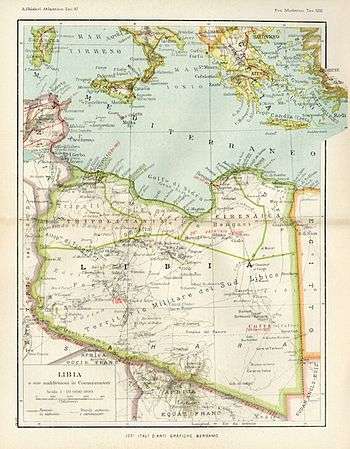Italo-Turkish War
The Italo-Turkish or Turco-Italian War (Turkish: Trablusgarp Savaşı, "Tripolitanian War"), also known in Italy as Guerra di Libia ("Libyan War") was fought between the Kingdom of Italy and the Ottoman Empire from September 29, 1911, to October 18, 1912. As a result of this conflict, Italy captured the Ottoman Tripolitania Vilayet (province), of which the main sub-provinces (sanjaks) were Fezzan, Cyrenaica, and Tripoli itself. These territories became the colonies of Italian Tripolitania and Cyrenaica, which would later merge into Italian Libya.
During the conflict, Italian forces also occupied the Dodecanese islands in the Aegean Sea. Italy agreed to return the Dodecanese to the Ottoman Empire in the Treaty of Ouchy[8] in 1912. However, the vagueness of the text allowed a provisional Italian administration of the islands, and Turkey eventually renounced all claims on these islands in Article 15 of the 1923 Treaty of Lausanne.[9]
Although minor, the war was a significant precursor of the First World War as it sparked nationalism in the Balkan states. Seeing how easily the Italians had defeated the weakened Ottomans, the members of the Balkan League attacked the Ottoman Empire starting the First Balkan War before the war with Italy had ended.
The Italo-Turkish War saw numerous technological changes, notably the airplane. On October 23, 1911, an Italian pilot, Capitano Carlo Piazza, flew over Turkish lines on the world's first aerial reconnaissance mission,[10] and on November 1, the first ever aerial bomb was dropped by Sottotenente Giulio Gavotti, on Turkish troops in Libya, from an early model of Etrich Taube aircraft.[11] The Turks, lacking anti-aircraft weapons, were the first to shoot down an aeroplane by rifle fire.[12] Another use of new technology was a network of wireless telegraphy stations established soon after the initial landings.[13] Guglielmo Marconi himself came to Libya to conduct experiments with the Italian Corps of Engineers.
Background
The claims of Italy over Libya dated back to Turkey's defeat by Russia in the war of 1877–1878 and subsequent discussions after the Congress of Berlin in 1878, in which France and Great Britain had agreed to the occupation of Tunisia and Cyprus respectively, both parts of the declining Ottoman Empire. When Italian diplomats hinted about possible opposition by their government, the French replied that Tripoli would have been a counterpart for Italy. Italy made a secret agreement with Great Britain in February 1887 by an exchange of notes.[14] It provided that Italy would support Great Britain and its role in Egypt while the Italians would receive British support in Libya.[15] In 1902, Italy and France had signed a secret treaty which accorded freedom of intervention in Tripolitania and Morocco.[16] The agreement negotiated by Italian foreign minister Giulio Prinetti and French ambassador Camille Barrère was an endpoint in the historical rivalry between the two nations for control of northern Africa. Also in 1902, Great Britain promised that "any alteration in the status of Libya would be in conformity with Italian interests." These measures were intended to loosen Italian commitment to the Triple Alliance and thereby weaken Germany, which France and Britain viewed as their main rival on the continent. Following the Anglo-Russian Convention and the establishment of the Triple Entente, Tsar Nicholas II and King Victor Emmanuel III made the 1909 Racconigi Bargain in which Russia acknowledged Italy's interest in Tripoli and Cyrenaica in return for Italian support for Russian control of the Bosphorus.[17] However, the Italian government did little to realize the opportunity and knowledge of Libyan territory and resources remained scarce in the following years.The removal of diplomatic obstacles coincided with increasing colonial fervor. In 1908, the Italian Colonial Office was upgraded to a Central Directorate of Colonial Affairs. Nationalist Enrico Corradini led the public call for action in Libya, and joined by the nationalist newspaper L'Idea Nazionale in 1911, demanded an invasion.[18] The Italian press began a large-scale lobbying campaign in favour of an invasion of Libya at the end of March 1911. It was fancifully depicted as rich in minerals, well-watered, and defended by only 4,000 Ottoman troops. Also, the population was described as hostile to the Ottoman Empire and friendly to the Italians: the future invasion was going to be little more than a "military walk", according to them.[19] Italy's government remained committed into 1911 to the maintenance of the Ottoman Empire, which was a close friend of their German ally. Prime Minister Giovanni Giolitti rejected nationalist calls for conflict over Ottoman Albania, which was seen as a possible colonial project, as late as the summer of 1911.
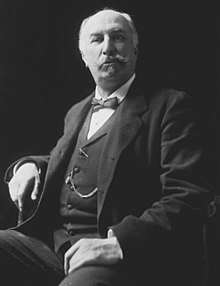
However, the Agadir Crisis, in which French military action in Morocco in April 1911 would lead to the establishment of a French protectorate, changed the political calculations. At this point, the Italian leadership decided that it could safely accede to public demands for a colonial project. The Triple Entente powers were highly supportive. British foreign secretary Edward Grey stated to the Italian ambassador on 28 July that they would support Italy and would not support the Turks; on 19 September, Grey instructed Permanent Under-secretary of State Sir Arthur Nicolson, 1st Baron Carnock that England and France should not interfere with Italy's designs on Libya. Meanwhile, the Russian government urged Italy to act in a "prompt and resolute manner." [20] In contrast to their engagement with the Entente powers, Italy largely ignored its military allies in the Triple Alliance. Giolitti and foreign minister Antonino Paternò Castello agreed on 14 September to launch a military campaign "before the Austrian and German governments [were aware] of it." At the time, Germany was actively attempting to mediate between Rome and Constantinople, while Austrian foreign minister Alois Lexa von Aehrenthal repeatedly warned Italy that military action in Libya would threaten the integrity of the Ottoman Empire and create a crisis in the Eastern Question, thereby destabilizing the Balkan peninsula and the continent's balance of power. Italy also foresaw this result: Paternò Castello, in a July report to the king and Giolitti, laid out the pros and cons of a military action in Libya and raised the concern that the Balkan revolt that would likely follow an Italian attack against Libya might force Austria to take military action in Balkan areas claimed by Italy.[21]
The Socialist Party had strong influence over public opinion. However, it was in opposition and also divided on the issue. It acted ineffectively against a military intervention. The future fascist leader Benito Mussolini – at this time still a left-wing Socialist – took a prominent anti-war position. A similar opposition was expressed in Parliament by Gaetano Salvemini and Leone Caetani.
An ultimatum was presented to the Ottoman government led by the Committee of Union and Progress (CUP) party on the night of 26–27 September 1911. Through Austrian intermediation, the Ottomans replied with the proposal of transferring control of Libya without war, maintaining a formal Ottoman suzerainty. This suggestion was comparable to the situation in Egypt, which was under formal Ottoman suzerainty but was actually controlled by the United Kingdom. Giolitti refused, and war was declared on September 29, 1911.
Military campaign
Opening maneuver

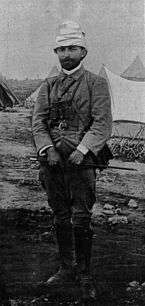
Despite the time it had had to prepare the invasion, the Royal Italian Army (Regio Esercito) was largely unprepared when the war broke out. The Italian fleet appeared off Tripoli in the evening of September 28, but only began bombarding the port on October 3. The city was conquered by 1,500 sailors, much to the enthusiasm of the interventionist minority in Italy. Another proposal for a diplomatic settlement was rejected by the Italians, and the Turks determined, therefore, to defend the province.[23]
The Turks did not have a full army in Tripolitania. Many of the Ottoman officers had to travel there by their own means, often secretly, through Egypt, since the British would not allow Turkish troops to be transported en masse through Egypt. The Ottoman Navy was too weak to transport troops by sea. The Turks organized local Libyans for the defence against the Italian invasion.[24]
Between 1911 and 1912, over 1,000 Somalis from Mogadishu, the then capital of Italian Somaliland, served as combat units along with Eritrean and Italian soldiers in the Italo-Turkish War.[25] Most of the Somalian troops stationed would only return home in 1935, when they were transferred back to Italian Somaliland in preparation for the invasion of Ethiopia.[26]
Italian troops landing in Libya
The first disembarkation of Italian troops occurred on October 10. The city of Tripoli and surroundings -after a destructive bombing of the Turkish fortifications- were quickly conquered by 1,500 Italian sailors, welcomed by the population (mainly the local Jews) who started to collaborate with the Italian authorities.[27]
The Italian contingent of 20,000 troops was deemed sufficient to accomplish the conquest at the time. Tobruk, Derna and Khoms were easily conquered, but the same was not true for Benghazi. The first true setback for the Italian troops happened on October 23 at Shar al-Shatt, when poor placement of the troops near Tripoli led them to be almost completely encircled by more mobile Arab cavalry, backed by some Turkish regular units. The attack was portrayed as a simple revolt by the Italian press, but it nearly annihilated much of the small Italian expeditionary corps.
The corps was consequently enlarged to 100,000 men who had to face 20,000 Libyans and 8,000 Turks. The war turned into one of position. Even some of the earliest examples of utilisation in modern warfare of armoured cars[28] and air power by the Italian forces had little effect on the initial outcome.[29] However, the war was notable for the first military use of heavier-than-air craft. Capitano Carlo Piazza flew the first military reconnaissance flight on 23 October 1911. A week later, Sottotenente Giulio Gavotti dropped four grenades on Tajura (Arabic: تاجوراء Tājūrā’), also spelt Tajoura, and Ain Zara in history's first aerial bombing.[30]
Trench phase
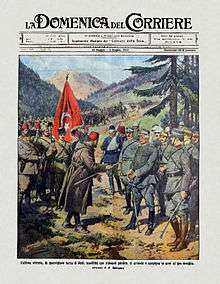
(From Italian weekly La Domenica del Corriere, 26 May – 2 June 1912).
The Libyans and Turks, estimated at 15,000, made frequent attacks by day and night on the strongly entrenched Italian garrison in the southern suburbs of Benghazi. The four Italian regiments of infantry acted on the defensive and were supported by the San Marco and Agordat. The Italians rarely attempted a sortie.[31]
An attack of 20,000 Turkish and local troops was repulsed on November 30 with considerable losses. Shortly after this, the garrison was reinforced by the 57th infantry regiment from Italy. The battleship Regina Elena also arrived from Tobruk. During the night of December 14 and 15, the Turks attacked in great force, but were repulsed with aid of the fire from the ships. The Italians lost several field guns.[31]
At Derna the Turks and Libyanas were estimated at 3,500, but they were being constantly reinforced and a general assault on the Italian position was expected. The Italian and Turkish forces in Tripoli and Cyrenaica were constantly reinforced. The withdrawal of the Turks into the interior enabled them to reinforce their troops considerably.[31]
The cost of the war was defrayed chiefly by voluntary offerings from Muslims. Turkish officers and men, weapons, ammunition, and all kinds of supplies were constantly sent across the Egyptian and Tunisian frontiers, notwithstanding their neutrality. The Italians occupied Sidi Barrani on the coast between Tobruk and Solum to prevent contraband and troops from entering across the Egyptian frontier, while the naval blockaders guarded the coast and captured several sailing ships with contraband.[31]
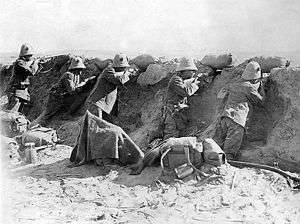
Italian troops landed at Tobruk after a brief bombardment on December 4, 1911, occupied the seashore and marched towards the hinterlands facing weak resistance.[32] Small numbers of Turkish soldiers and Libyan volunteers were later organized by Captain Mustafa Kemal Atatürk. The small December 22 Battle of Tobruk resulted in Mustafa Kemal's victory.[33] With this achievement, he was assigned to Derna War quarters to coordinate the field on March 6, 1912. The Libyan campaign ground to a stalemate by December 1911.[5]
On 3 March 1912, 1,500 Libyan volunteers attacked Italian troops who were building trenches near Derna. The Italians, who were outnumbered but had superior weaponry, held the line. A lack of coordination between the Italian units sent from Derna as reinforcements and the intervention of Turkish artillery threatened the Italian line, and the Libyans attempted to surround the Italian troops. Further Italian reinforcements, however, were able to stabilise the situation, and the battle ended in the afternoon with an Italian victory.
On September 14, the Italian command sent three columns of infantry to disband the Arab Turkish camp near Derna. The Italian troops occupied a plateau, interrupting Turkish supply lines. Three days later, the Turkish commander, Enver Bey, attacked the Italian positions on the plateau. The larger Italian fire drove back the Turkish soldiers, who were surrounded by a battalion of Alpini and suffered heavy losses. A later Turkish attack had the same outcome. After that, operations in Cyrenaica ceased until the end of the war. Although some elements of the local population collaborated with the Italians, counterattacks by Turkish soldiers with the help of local troops confined the Italian army to the coastal region.[7] In fact, by the end of 1912 the Italians had made little progress in conquering Libya. The Italian soldiers were, in effect, besieged in seven enclaves on the coasts of Tripolitania and Cyrenaica.[34] The largest of these, at Tripoli, extended barely 15 kilometers (9.3 miles) from the town.[34]
Naval warfare
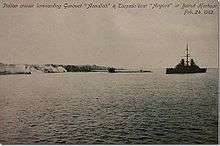
At sea, the Italians enjoyed a clear advantage. The Italian navy had seven times the tonnage of the Ottoman navy and was better trained.[35]
In January 1912, the Italian cruiser Piemonte, with the Soldato class destroyers Artigliere and Garibaldino, sank seven Turkish gunboats (Ayintab, Bafra, Gökcedag, Kastamonu, Muha, Ordu and Refahiye) and a yacht (Sipka) in the Battle of Kunfuda Bay. The Italians blockaded the Red Sea ports of the Ottomans, while actively supplying and supporting the Emirate of Asir which was also concurrently at war with the Ottoman Empire.[36]
Then, on 24 February, in the Battle of Beirut, two Italian armoured cruisers attacked and sank an Ottoman casemate corvette and six lighters, retreated, then returned and sank an Ottoman torpedo boat. Avnillah alone suffered 58 killed and 108 wounded. By contrast, the Italian ships not only took no casualties but no direct hits from the Ottoman warships at all.[37] Italy had feared that the Ottoman naval forces at Beirut could be used to threaten the approach to the Suez Canal. The Ottoman naval presence at Beirut was completely annihilated and casualties on the Ottoman side were heavy. The Italian navy gained complete naval dominance of the southern Mediterranean for the rest of the war.
Although Italy could extend its control to almost all of the 2,000 km of the Libyan coast between April and early August 1912, its ground forces could not venture beyond the protection of the navy's guns and were thus limited to a thin coastal strip. In the summer of 1912, Italy began operations against the Turkish possessions in the Aegean Sea with the approval of the other powers that were eager to end a war that was lasting much longer than expected. Italy occupied twelve islands in the sea, comprising the Ottoman province of Rhodes, which henceforth became known as the Dodecanese, but this raised the discontent of Austria-Hungary, which feared that this could fuel the irredentism of nations such as Serbia and Greece, causing imbalance in the already fragile situation in the Balkan area. The only other relevant military operation of the summer was an attack of five Italian torpedo boats in the Dardanelles on 18 July.
Irregular war and atrocities

With a decree of November 5, 1911, Italy declared its sovereignty over Libya. Although it controlled the coast, many of the Ottoman troops were not killed in battle and nearly 6,000 remained to face an army of nearly 140,000 Italians. As a result, the Ottomans began using guerrilla tactics. Indeed, some "Young Turk" officers reached Libya and helped organize a guerrilla war with local mujahideens.[38] Many local Libyans joined forces with the Turks because of their common faith against the "Christian invaders" and started a bloody guerrilla warfare: Italian authorities adopted many repressive measures against the rebels, such as public hanging as a retaliation for ambushes.
On October 23, 1911, nearly 500 Italian soldiers were slaughtered by Turkish troops at Sciara Sciatt, on the outskirts of Tripoli.[39] As a consequence, on the next day—during the 1911 Tripoli massacre—Italian troops systematically murdered thousands of civilians by moving through local homes and gardens one by one, including setting fire to a mosque with one hundred refugees inside.[40] Although Italian authorities attempted to keep the news of the massacre from getting out, the incident soon became internationally known.[40] The Italians started to show photos of the massacred Italian soldiers at Sciara Sciat in order to justify their revenge.
Treaty of Ouchy
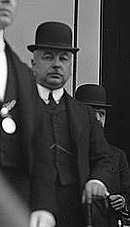
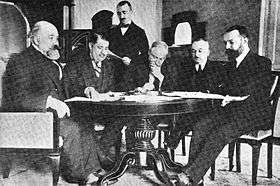
Italian diplomats decided to take advantage of the situation to obtain a favourable peace deal. On October 18, 1912, Italy and the Ottoman Empire signed a treaty in Ouchy near Lausanne called The First Treaty of Lausanne, often also called Treaty of Ouchy to distinguish it from the 1923 Treaty of Lausanne, (The second Treaty of Lausanne).[41][42]
The main provisions of the treaty were as follows:[43]
- The Ottomans would withdraw all military personnel from Trablus and Benghazi vilayets (Libya) but in return, Italy would return Rhodes and the other Aegean islands it held back to the Turks.
- Trablus and Benghazi vilayets would have a special status and a naib (regent) and a kadi (judge) would represent the Caliph.
- Before the appointment of these kadis and naibs, the Ottomans would consult the Italian government.
- The Ottoman government would be responsible for the expenses of these kadis and naibs.
Aftermath
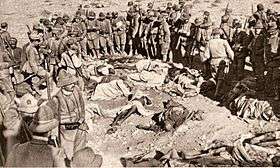
The invasion of Libya was a costly enterprise for Italy. Instead of the 30 million lire a month judged sufficient at its beginning, it reached a cost of 80 million a month for a much longer period than was originally estimated. The war cost Italy 1.3 billion lire, nearly a billion more than Giovanni Giolitti estimated before the war.[44] This ruined ten years of fiscal prudence.[44]
After the withdrawal of the Ottoman army the Italians could easily extend their occupation of the country, seizing East Tripolitania, Ghadames, the Djebel and Fezzan with Murzuk during 1913.[45] The outbreak of the First World War with the necessity to bring back the troops to Italy, the proclamation of the Jihad by the Ottomans and the uprising of the Libyans in Tripolitania forced the Italians to abandon all occupied territory and to entrench themselves in Tripoli, Derna, and on the coast of Cyrenaica.[45] The Italian control over much of the interior of Libya remained ineffective until the late 1920s, when forces under the Generals Pietro Badoglio and Rodolfo Graziani waged bloody pacification campaigns. Resistance petered out only after the execution of the rebel leader Omar Mukhtar on September 15, 1931. The result of the Italian colonisation for the Libyan population was that by the mid-1930s it had been cut in half due to emigration, famine, and war casualties. The Libyan population in 1950 was at the same level as in 1911, approximately 1.5 million.[46]
Europe, the Balkans, and the First World War
In 1924, the Serbian diplomat Miroslav Spalajković could look back on the events that led to the First World War and its aftermath and state of the Italian attack, "all subsequent events are nothing more than the evolution of that first aggression."[47] Unlike British-controlled Egypt and French-influenced Morocco, the Ottoman Tripolitania vilayet that made up modern-day Libya were core territory of the Empire, like that of the Balkans.[48] The coalition that had defended the Ottomans during the Crimean War (1853-1856), minimized Ottoman territorial losses at the Congress of Berlin (1878), and supported the Empire during the Bulgarian Crisis (1885–88) had largely disappeared.[49] The reaction in the Balkans to the Italian declaration of war was immediate. The first draft by Serbia of a military treaty with Bulgaria against Turkey was written by November 1911, with a defensive treaty signed in March 1912, and an offensive treaty signed in May 1912 focused on military action against Ottoman south-east Europe. The series of bilateral treaties between Greece, Bulgaria, Serbia and Montenegro that created the Balkan League was completed in 1912, with the First Balkan War (1912-1913) beginning with a Montenegrin attack on 8 October 1912, ten days before Treaty of Lausanne.[50] The swift and nearly complete victory of the Balkan League astonished contemporary observers.[51] However, the Serbs were unhappy with the division of captured territory and continued to hold areas promised to Bulgaria, resulting in the Second Balkan War (1913), in which Serbia, Greece, the Ottomans, and Romania took almost all of the territory that Bulgaria had captured in the first war.[52] In the wake of this enormous change in the regional balance of power, Russia switched its primary allegiance in the region from Bulgaria to Serbia, guaranteeing Serbian autonomy from any outside military intervention. The assassination of Archduke Franz Ferdinand, heir to the Austro-Hungarian throne, by a Serbian nationalist and the resulting Austrian plan for military action against Serbia is the oft-stated precipitating event of World War I (1914-1918)
The Italo-Turkish War illustrated to France and Great Britain that Italy was more valuable to them inside the Triple Alliance, rather than formally allied with the Entente. In January 1912, French diplomat Paul Cambon wrote to Raymond Poincaré that Italy was "more burdensome than useful as an ally. Against Austria, she harbours a latent hostility that nothing can disarm."[53] The tensions within the Triple Alliance would eventually lead Italy to sign the 1915 Treaty of London abandoning the Triple Alliance and joining the Entente.
In Italy itself, massive funerals for fallen heroes brought the Catholic Church closer to the government from which it had long been alienated. There emerged a cult of patriotic sacrifice, in which the colonial war was celebrated in an aggressive and imperialistic way. The ideology of "crusade" and "martyrdom" characterized the funerals. The result was to consolidate Catholic war culture among devout Italians, which was soon expanded to include the world war (1915–18). This aggressive spirit was revived by the Fascists in the 1920s to strengthen their popular support.[54]
Fate of the Dodecanese Islands
Because of World War I, the Dodecanese remained under Italian military occupation. According to the 1920 Treaty of Sèvres, which was never ratified, Italy was supposed to cede all of the islands except Rhodes to Greece, in exchange for a vast Italian zone of influence in southwest Anatolia. However, the Greek defeat in the Greco–Turkish War and the foundation of modern Turkey created a new situation that made the enforcement of the terms of this treaty impossible. In article 15 of the 1923 Treaty of Lausanne, which superseded the 1920 Treaty of Sèvres, Turkey formally recognized the Italian annexation of the Dodecanese. The population was largely Greek, and by treaty in 1947 the islands eventually became part of Greece.[55]
Notes
- Erik Goldstein (2005). Wars and Peace Treaties: 1816 to 1991. Routledge. p. 37. ISBN 9781134899128.
- Italy. Esercito. Corpo di stato maggiore (1914). The Italo-Turkish War (1911–12). Franklin Hudson Publishing Company. p. 13.
- The History of the Italian-Turkish War, William Henry Beehler, p.13-36
- World War I: A Student Encyclopedia, Spencer C. Tucker, Priscilla Mary Roberts, page 946
- Emigrant nation: the making of Italy abroad, Mark I. Choate, Harvard University Press, 2008, ISBN 0-674-02784-1, page 176.
- James C. Bradford: International Encyclopedia of Military History, Routledge 2006, page 674
- Spencer Tucker, Priscilla Mary Roberts: World War I: A Student Encyclopedia, ABC-CLIO, 2005, ISBN 1-85109-879-8, page 946.
- "Treaty of Lausanne, October, 1912". www.mtholyoke.edu. Retrieved 25 March 2018.
- "Treaty of Lausanne - World War I Document Archive". wwi.lib.byu.edu. Retrieved 25 March 2018.
- Maksel, Rebecca. "The World's First Warplane". airspacemag.com. Retrieved 25 March 2018.
- U.S. Centennial of Flight Commission: Aviation at the Start of the First World War Archived 2012-10-09 at the Wayback Machine
- James D. Crabtree: On air defense, ISBN 0275947920, Greenwood Publishing Group, page 9
- Wireless telegraphy in the Italo-Turkish War
- A.J.P. Taylor (1954). The Struggle for Mastery in Europe, 1848-1918. p. 311.
- Andrea Ungari (2014). The Libyan War 1911-1912. p. 117.
- "Alliance System / System of alliances". thecorner.org. Retrieved 2007-04-03.
- Clark, Christopher M. (2012). The Sleepwalkers: How Europe Went to War in 1914. London: Allen Lane. p. 244. ISBN 9780713999426. LCCN 2012515665.
- Clark, pp. 244-245
- Andrea L. Stanton et al eds. (2012). Cultural Sociology of the Middle East, Asia, and Africa: An Encyclopedia. SAGE. p. 310.CS1 maint: extra text: authors list (link)
- Clark, pp. 245-246
- Clark, pp. 246
- Biddle, Rhetoric and Reality in Air Warfare, pg.19
- 30 September Italy and Trablusgarp (tr) Archived 2012-09-15 at the Wayback Machine
- M. Taylan Sorgun, "Bitmeyen Savas", 1972. Memoirs of Halil Pasa
- W. Mitchell. Journal of the Royal United Service Institution, Whitehall Yard, Volume 57, Issue 2. p. 997.
- William James Makin (1935). War Over Ethiopia. p. 227.
- Tripoli inhabitants welcomed the Italians, p. 36-40 (in Italian)
- Crow, Encyclopedia of Armored Cars, pg.104.
- Biddle, Rhetoric and Reality in Air Warfare, pg.19.
- Hallion Strike From the Sky: The History of Battlefield Air Attack, 1910–1945, p. 11.
- William Henry Beehler, The History of the Italian-Turkish War, September 29, 1911, to October 18, 1912, Engagements At Benghasi And Derna In December 1911 (p.49)
- "1911–1912 Turco-Italian War and Captain Mustafa Kemal". Ministry of Culture of Turkey, edited by Turkish Armed Forces-Division of History and Strategical Studies, pages 62–65, Ankara, 1985.
- "1911–1912 Turco-Italian War and Captain Mustafa Kemal". Ministry of Culture of Turkey, edited by Turkish Armed Forces-Division of History and Strategical Studies, pages 62–65, Ankara, 1985.
- Libya: a modern history", John Wright, Taylor & Francis, 1981, ISBN 0-7099-2727-4, page 28.
- Tucker, Roberts, 2005, page 945.
- Chisholm, Hugh (25 March 2018). "The Encyclopedia Britannica: a dictionary of arts, sciences, literature and general information". The Encyclopedia Britannica Co. Retrieved 25 March 2018 – via Google Books.
- Beehler, William (1913). The history of the Italian-Turkish War, September 29, 1911, to October 18, 1912. Annapolis: The Advertiser Republican. p. 58.
awn illah.
- "Arab Thoughts on the Italian Colonial Wars in Libya - Small Wars Journal". smallwarsjournal.com. Retrieved 25 March 2018.
- Gerwarth, Robert; Manela, Erez (3 July 2014). "Empires at War: 1911-1923". OUP Oxford. Retrieved 25 March 2018 – via Google Books.
- Geoff Simons (2003). Libya and the West: From Independence to Lockerbie. I.B.Tauris. p. 7. ISBN 978-1-86064-988-2.
- Treaty of Peace Between Italy and Turkey The American Journal of International Law, Vol. 7, No. 1, Supplement: Official Documents (Jan., 1913), pp. 58–62 doi:10.2307/2212446
- "Treaty of Lausanne, October, 1912". Mount Holyoke College, Program in International Relations.
- "Uşi (Ouchy) Antlaşması" [Treaty of Ouchy] (in Turkish). Bildirmem.com. 31 May 2009. Archived from the original on 3 September 2010. Retrieved 24 August 2010.
- Mark I. Choate: Emigrant nation: the making of Italy abroad, Harvard University Press, 2008, ISBN 0-674-02784-1, page 175.
- Bertarelli (1929), p. 206.
- The Libyan Economy: Economic Diversification and International Repositioning, Waniss Otman, Erling Karlberg, page 13
- Clark, pp.243-244
- Clark, pp.243
- Clark, p. 250
- Clark, pp. 251-252
- Clark, p. 252
- Clark, pp. 256-258
- Clark, p. 249
- Matteo Caponi, "Liturgie funebri e sacrificio patriottico I riti di suffragio per i caduti nella guerra di Libia (1911-1912)."["Funeral Liturgies and Patriotic Sacrifices: The Rites for the Souls of Those Who Fell in the War of Libya (1911-1912)"] Rivista di storia del cristianesimo 10.2 (2013) 437-459
- P.J. Carabott, "The Temporary Italian Occupation of the Dodecanese: A Prelude to Permanency," Diplomacy and Statecraft," (1993) 4#2 pp 285–312.
Further reading
- Askew, William C. Europe and Italy's Acquisition of Libya, 1911–1912 (1942) online
- Baldry, John (1976). "al-Yaman and the Turkish occupation 1849–1914". Arabica. 23: 156–96.
- Beehler, William Henry. The history of the Italian-Turkish War, September 29, 1911, to October 18, 1912. (1913; reprint: Harvard University Press, 2008)
- Biddle, Tami Davis, Rhetoric and Reality in Air Warfare: The Evolution of British and American Ideas about Strategic Bombing, 1914–1945. Princeton University Press, 2002. ISBN 978-0-691-12010-2.
- Childs, Timothy W. Italo-Turkish Diplomacy and the War Over Libya, 1911–1912. Brill, Leiden, 1990. ISBN 90-04-09025-8.
- Crow, Duncan, and Icks, Robert J. Encyclopedia of Armored Cars. Chatwell Books, Secaucus, New Jersey, 1976. ISBN 0-89009-058-0.
- Hallion, Richard P. Strike From the Sky: The History of Battlefield Air Attack, 1910–1945. (second edition) University of Alabama Press, 2010. ISBN 0817356576, 9780817356576.
- Paris, Michael. Winged Warfare. Manchester University Press, New York, 1992, pp. 106–115.
- Stevenson, Charles. A Box of Sand: The Italo-Ottoman War 1911–1912: The First Land, Sea and Air War (2014), a major scholarly study
- Vandervort, Bruce. Wars of imperial conquest in Africa, 1830–1914 (Indiana University Press, 1998)
In other languages
- Bertarelli, L.V. (1929). Guida d'Italia, Vol. XVII (in Italian). Milano: Consociazione Turistica Italiana.
- Maltese, Paolo. "L'impresa di Libia", in Storia Illustrata #167, October 1971.
- "1911–1912 Turco–Italian War and Captain Mustafa Kemal". Ministry of Culture of Turkey, edited by Turkish Armed Forces-Division of History and Strategical Studies, pages 62–65, Ankara, 1985.
- Schill, Pierre. Réveiller l'archive d'une guerre coloniale. Photographies et écrits de Gaston Chérau, correspondant de guerre lors du conflit italo-turc pour la Libye (1911-1912), éd. Créaphis, 2018. 480 pages and 230 photographs. ISBN 978-2-35428-141-0
Awaken the archive of a colonial war. Photographs and writings of a French war correspondent during the Italo-Turkish war in Libya (1911-1912). With contributions from art historian Caroline Recher, critic Smaranda Olcèse, writer Mathieu Larnaudie and historian Quentin Deluermoz.
- "Trablusgarp Savaşı Ve 1911–1912 Türk-İtalyan İlişkileri: Tarblusgarp Savaşı'nda Mustafa Kemal Atatürk'le İlgili Bazı Belgeler", Hale Şıvgın, Türk Tarih Kurumu Basımevi, 2006, ISBN 978-975-16-0160-5
External links
![]()
- Antonio De Martino.Tripoli italiana Societa Libraria italiana (Library of Congress). New York, 1911
- Turco-Italian War at Turkey in the First World War website
- Johnston, Alan (2011-05-10). "Libya 1911: How an Italian pilot began the air war era". BBC News Online. Retrieved 10 May 2011.
- Map of Europe during Italo-Turkish War at omniatlas.com
- V. I. Lenin, The End of the Italo-Turkish War, September 28, 1912.
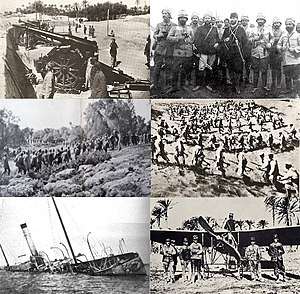
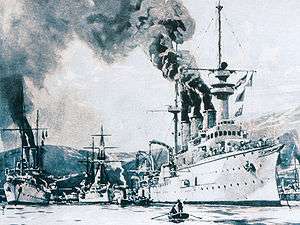
.svg.png)
